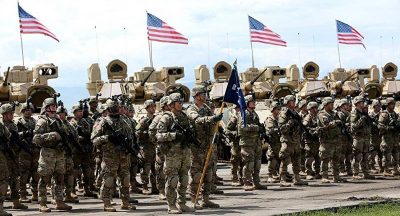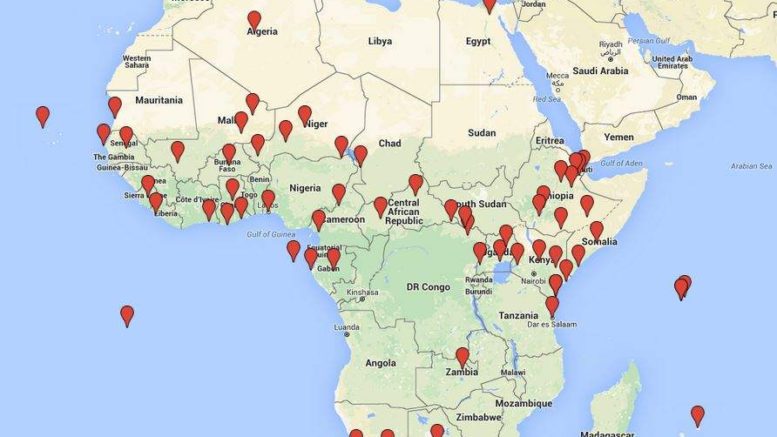By Shane Quinn Global Research, December 06, 2019 Region: Middle East & North Africa Theme: Militarization and WMD, US NATO War Agenda


Africa now contains 1.3 billion inhabitants, almost twice that of Europe’s population, and the number of African people continues expanding rapidly in what comprises the world’s second biggest continent.
Following five centuries of pillage and exploitation by Western imperial powers, Africa is today riddled with poverty and social injustice. Africa remains a sought after land mass for the world’s strongest states. One of the reasons for this is that two African nations, Libya in the north and Nigeria further south, contain the world’s 9th and 10th largest oil reserves respectively.
Among the motives behind the March 2011 United States-NATO military assault on Libya, was to reinstate control over that country’s oil sources, which under Muammar Gaddafi was becoming increasingly uncertain. Seven months later, on 20 October 2011, Gaddafi was viciously murdered by NATO-backed forces. His son Mutassim Gaddafi, the former National Security Advisor of Libya, was also killed that same day in a premeditated and cold-blooded fashion.
The 69-year-old Gaddafi’s unseemly death was generally applauded in the West. Norway’s then prime minister Jens Stoltenberg, and the current NATO Secretary General, described Gaddafi’s liquidation as “a turning point for Libya”. Indeed, it was a turning point, as Libya was splintered apart into warring factions, with the nation since descending into chaos and ruin. Britain’s prime minister at the time, David Cameron, said upon hearing of Gaddafi’s death that Libya would have “an even greater chance, after this news, of building themselves a strong and democratic future”.
On the international scene condemnation of Gaddafi’s murder was a rare thing, and came from those such as Fidel Castro and Hugo Chavez – with the Cuban leader noting that his killing was something “which violates the most elementary principles of Islamic rules” while Chavez denounced it as “another outrage”.
NATO chiefs were satisfied, however, as it removed an obstacle to US control over Libya’s oil sources, a country which also has an extensive coastline along the Mediterranean Sea. One of the primary tasks of NATO is to safeguard access to raw materials and strategic localities. In June 2007 NATO’s then Secretary General, Jaap de Hoop Scheffer, said to a gathering of members in Brussels that “NATO troops have to guard pipelines that transport oil and gas that is directed to the West”. Another of NATO’s functions is “to protect sea routes used by tankers and other ‘crucial infrastructure’ of the energy system”.
A separate reason behind the US-led attack on Libya was to stem the tide of Arab Spring revolts, which first broke out in Tunisia during December 2010. Tunisia borders Libya to the west, with protests in the following weeks spreading to other nearby states like Egypt. Contrary to misrepresentations in Western media, the Arab Spring was looked upon with much concern by First World leaders.
As has been known for decades along the corridors of power in Washington and London, nationalist movements or popular uprisings – and not communism or terrorism – has constituted the biggest threat to Western hegemony and control over foreign resources. The purported spectre of communism was used as a smokescreen by leaders to frighten the public and keep them in line. It has seldom ever been desirable for imperial states to promote real democratic ideals abroad, which is incompatible with their core interests regarding oil and gas, along with control over other mineral reserves.
George Kennan, the famous American planner and historian, outlined in a top secret document dated 24 February 1948 that, “We need not deceive ourselves that we can afford today the luxury of altruism and world benefaction” including “unreal objectives such as human rights, the raising of the living standards, and democratization”. Two years later, in 1950, Kennan recognised that the imperative need was for the “protection of our raw materials”. These views remain relevant right up to today.US Military Presence in Africa: All Over Continent and Still Expanding
Following the intervention against Libya, US predominance over this north African country has largely been restored. In June 2019 Ahmed Maiteeq, the Libyan deputy prime minister, called the US “our main ally”, while Libya is in the midst of a destructive civil war ongoing for over five years.
The African continent contains about 30% of the world’s remaining mineral resources, ranging from diamonds and copper to gold and silver. Parts of Africa are also rich in lithium, a natural element which has become increasingly sought after. For example, lithium is an essential material used to power batteries for electric cars, and there are great levels of this substance in countries like Mali, Zimbabwe and the Democratic Republic of the Congo (DR Congo).
Mainly because of vested interests embedded in fossil fuel production, the electric car industry has been painfully slow to emerge. Petrol and diesel-fuelled vehicles account for almost 20% of world carbon emissions. With growing pressure upon governments to tackle climate change, the number of electric cars globally will surely multiply in the years to come, thereby increasing the demand for lithium.
Since 2009, Africa’s largest trading partner has been none other than China, which overtook the US that year. At the start of this century, Beijing’s trade levels with Africa stood at just $10 billion. By 2014 it had risen to $220 billion, before declining somewhat to $170 billion in 2017.
Beijing’s financial dealings with Africa are indeed a recent phenomenon, and trade exchanges provide China with only limited sway on the African continent. As a consequence, reports of China “taking over Africa” are very likely overstated and unrealistic.
China possesses just one army base overseas, which was opened in August 2017 and is located in the east African country of Djibouti. While China seeks influence abroad mainly through its financial and industrial initiatives, Washington focuses primarily on means of force. The Pentagon today controls 36 military bases in Africa, most of which are located along the continent’s strategically vital regions, in central and eastern Africa.
There are now about 7,000 US troops stationed on African soil, as part of US Africa Command (AFRICOM) – something which is barely known among the American public. US congressmen, like Lindsey Graham of South Carolina, have expressed surprise on learning the true extent of US militarism in little known African countries like Niger. In 2008, the year that AFRICOM began its operations, Washington had only 2,600 soldiers in Africa. This year alone, two new US bases have opened for business, one in landlocked Niger and the other in Somalia, the latter situated in the Horn of Africa.
The Horn of Africa, on the continent’s far east, is one of the most prized territories in Africa. It juts out into the Indian Ocean and Arabian Sea, providing a field of air and naval operations in important regions. Furthermore, situated just a few hundred miles north-eastwards of the Horn of Africa lies oil rich Saudi Arabia, which can be reached by crossing the Red Sea.
Unsurprisingly, Washington has implemented an enlarging military presence in Horn of Africa countries like Somalia, where 500 American soldiers are today based, compared to just 50 US soldiers present in Somalia three years ago.
Moving upwards past Somalia, the Americans can deploy aircraft or utilise their navy to reach the Strait of Hormuz and Persian Gulf waters. These rich seas are linked together in one way or another, and guarantee Washington power over resources.
Since president Donald Trump assumed office nearly three years ago, the US military has conducted dozens of air strikes in Somalia against “extremists”; inevitably, civilians are killed in these attacks, which are sometimes carried out indiscriminately or based on faulty intelligence reports.
The US footprint in Somalia is still a fraction compared to its status in neighbouring Djibouti, also in the Horn of Africa – where 4,000 American military personnel reside in Djibouti City, at Camp Lemonnier, the “crown in the jewel” of US bases in Africa. The Pentagon pays more than $60 million annually for its military’s use of the Camp Lemonnier base, and has a contract to continue leasing it until 2034.
Washington’s interest in Djibouti is at least partly due to the strategic significance of this tiny east African nation. Directly off Djibouti’s northern coast lies the Bab el-Mandeb Strait. In 2018, 6.2 million barrels of crude oil and refined petroleum were each day shipped through the Bab el-Mandeb Strait, and the numbers have been steadily increasing. This Strait now accounts for almost 10% of total seaborne oil shipped globally.
Powerful concerns are at stake here, as a sizable amount of these resources are sent to America, along with Europe and Asia. The Strait is a link between the Horn of Africa and Middle East, which furthermore connects the Gulf of Aden to the Red Sea.
Meanwhile, a growing proportion of US operations in Africa relates to drone attacks, in which an unmanned combat aerial vehicle (UCAV) targets below persons, buildings, installations, etc. Drones are armed with weapons like Hellfire missiles, which have been modified over the years.
Since 2011, the Pentagon has carried out around 600 drone strikes in Libya, and rising levels of these attacks have been witnessed in Somalia too. Drone warfare has proven to be a particularly harmful military action and, as has been documented, each drone assault can produce more extremists than will conceivably be killed. US drone attacks have terrorised civilian inhabitants around Africa and the Middle East, playing a role in radicalising communities and imbuing them with hostile attitudes towards America.
The Pentagon also has drones in flight above other African nations like Chad, Cameroon and Niger. Washington boasts a considerable foothold in Niger, where at least 800 US troops are stationed. It has been reported that American soldiers are active in Niger to help train local armies in the fight against Boko Haram, a terrorist organisation which in March 2015 pledged allegiance to Islamic State (ISIS). However, in one way or another, Washington’s foreign policies over the past 40 years have been a pivotal factor in the disturbing rise of terrorist groups in the Eastern hemisphere.
Niger and its American squadrons are positioned in an important area too: to the south lies neighbour and US ally Nigeria, rich in oil and gas and Africa’s most populous country. Boko Haram’s headquarters are located in north-eastern Nigeria, and this Jihadist group are also active in nearby states such as Chad and Cameroon.
The Trump administration’s supposed bid to wipe out Boko Haram by force of arms has been dismissed by Washington-based think tanks, like the Center for International Policy (CIP). William Hartung, a director at CIP and an experienced American military analyst, recently rebuked the Pentagon for its “overly militarized approach” in Africa, which he feels “has been a dismal failure”.
Hartung says that attempts “to eradicate terrorism by force may be exacerbating the problem, provoking a terrorist backlash and serving as a recruiting tool for extremist groups”.
*
Note to readers: please click the share buttons above or below. Forward this article to your email lists. Crosspost on your blog site, internet forums. etc.
Shane Quinn obtained an honors journalism degree. He is interested in writing primarily on foreign affairs, having been inspired by authors like Noam Chomsky. He is a frequent contributor to Global Research.
Featured image is from InfoRos The original source of this article is Global Research Copyright © Shane Quinn, Global Research, 2019

